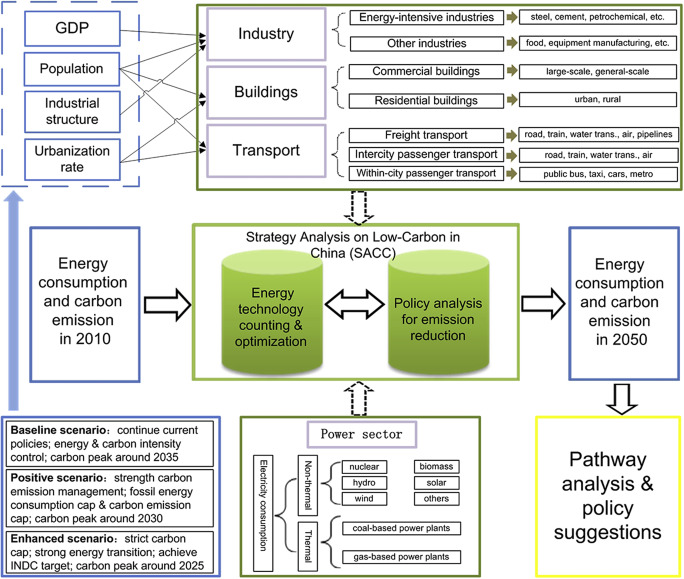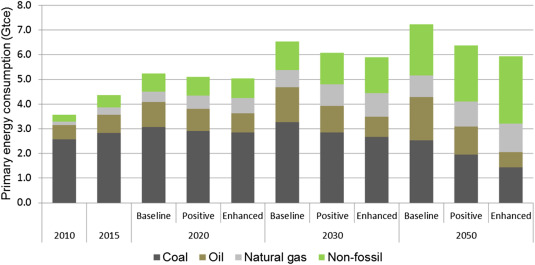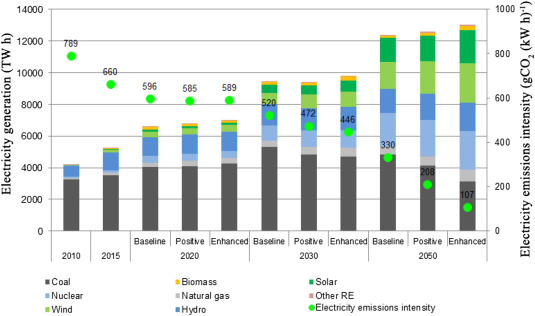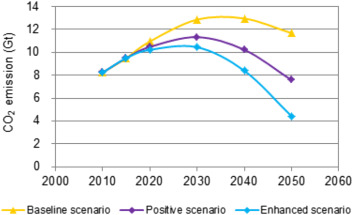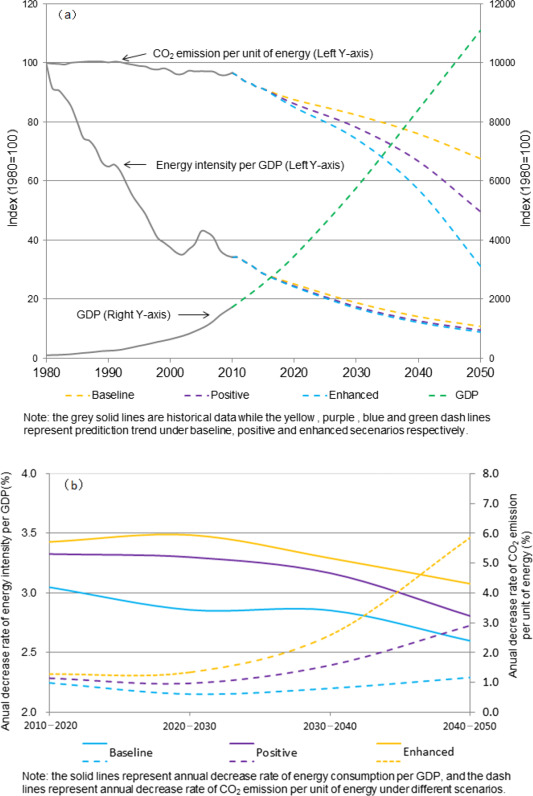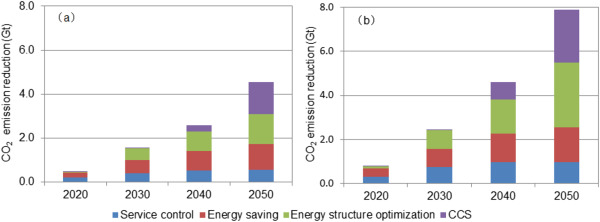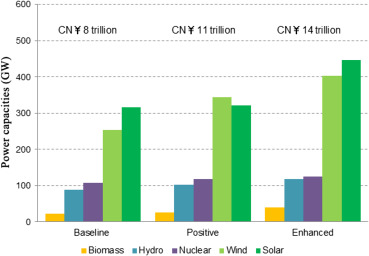(Created page with "==Abstract== In recent years, there have been considerable developments in energy provision with the growing improvements in energy supply security and support systems in Chi...") |
m (Scipediacontent moved page Draft Content 363173560 to Liu et al 2016d) |
(No difference)
| |
Latest revision as of 10:32, 15 May 2017
Abstract
In recent years, there have been considerable developments in energy provision with the growing improvements in energy supply security and support systems in China. However, Chinas energy system continues to retain a high-carbon feature where coal dominates energy production and consumption, which has led to the rapid growth of greenhouse gas emissions and associated serious environmental pollution. It has therefore become an important task for China to consider how to promote the low-carbon development of energy system. This paper summarized the basic trends and challenges for development of low-carbon energy system in China and studied the primary energy consumption and carbon emissions in different scenarios at 10-year intervals between 2010 and 2050. The analysis showed that controlling coal consumption will have an important influence on the control of total carbon emissions and of carbon emission peaking; promotion of non-fossil fuel energies will offer a growing contribution to a low-carbon transition in the medium and long term; the development of carbon capture, utilization, and storage will play a key role in realizing a deep decarbonization pathway, particularly after 2030; and the establishment of a low-carbon power system is crucial for the achievement of low-carbon energy transition. Finally, the strategic considerations and policy suggestions on the development of low-carbon energy systems in China are explored.
Keywords
Low-carbon energy ; Scenario analysis ; Strategic deliberation
1. Introduction
The Chinese government has launched revolutionary measures for energy production and consumption by imposing a ceiling on total energy consumption, enhancing energy conservation, supporting the development of new and renewable energy. Meanwhile, the Chinese government has officially announced to achieve CO2 emission peak around 2030 with the intention trying to peak early, and increase the share of non-fossil energy in primary energy consumption to about 20% by 2030, as determined in the China–U.S. Joint Statement on Climate Change in 2014 (XNA, 2014 ). China has released its new commitment of reducing emissions intensity by 60%–65% from 2005 level by 2030 in its recently released Chinas Intended Nationally Determined Contributions1 (INDCs) in 2015 (NDRC, 2015 ). These strategies and targets clearly reflect Chinas ambition in the development of a low-carbon energy system in China.
There have been many studies on the development targets and approaches of low-carbon energy system with the utilization of various models and scenarios, such as those done by ERI, 2009 , Li and Qi, 2011 , Chai and Xu, 2014 , Wang and Zou, 2014 , Yuan et al., 2014 and Elzen et al., 2016 , etc. These studies provided a broad picture of development trend in energy system under different assumptions and conditions and put forward different solutions for China to achieve the low-carbon energy development. However, along with the new international and domestic circumstances that China has gone through in recent years and the enhanced commitment and actions by the Chinese government on low-carbon development, it is necessary to reexamine the energy and carbon emission scenarios to strengthen the analysis on low-carbon energy development pathway in China.
In this respect, this study develops 3 scenarios, i.e. baseline, positive and enhanced scenarios, to simulate primary energy consumption and CO2 emission from 2010 to 2050 in China, by deeply analyzing economic and social driving forces and exploring the sectoral and technological potentials for carbon emission reduction. The next sections will analyze the development trends and challenges for Chinas low-carbon energy system, summary and compare 3 different scenarios, and provide strategic deliberation on development of low-carbon energy system in China.
2. Development of low-carbon energy system in China: general perspective
2.1. Basic trend in development of low-carbon energy system in China
Energy consumption in China has entered into a new era, which will continue to grow for quite a considerable time period but will experience a much slower growth rate in the future. Since the 21st century, energy consumption in China has soared from 1.46 Gtce in the year 2000 to 4.26 Gtce in 2014, thereby exceeding the consumption of any other country globally and accounting for 22% of total global energy consumption (NBSC, 2015 ). This figure represents a comparatively low energy consumption per capita in China (approximately 3 tce per capita, which is only 2/3 of that in Organization for Economic Co-operation and Development (OECD) countries) (IEA, 2014a ); however, it is predicted that there will be continued growth in total energy demand over a prolonged time period, particularly with further increases in industrialization and accelerated urbanization within the country. Through an analysis of major driving factors involved in energy consumption, it has been indicated that the actual growth rate in energy consumption within China will gradually decrease and become more reasonable. As China enters into a new era, which is described as the new normal, it is expected that the economy will gradually transit from a pattern focusing on quantity to one focusing on quality. Nevertheless, in view of the application of emerging low-carbon technologies in sectors such as power generation, the manufacturing industry, and the building and transportation sector, it is considered that energy consumption in China will continue to grow for more than 20 years but will experience a quite low growth rate or even stable in the future.
The development of clean and low-carbon energy has gained a good basis and is expected to undergo rapid advancement in the future. To boost the development of clean and low-carbon energy, China has established major institutional mechanisms and policy frameworks that promote the development of low-carbon energies such as natural gas and non-fossil energies. Chinas natural gas consumption increased from 34.1 billion m3 in 2004 to 180 billion m3 in 2014, making the country the worlds third largest natural gas consumer. However, primary energy consumption of non-fossil energies has increased in proportion from 4.0% in 1980 to 11.2% in 2014 (NBSC, 2015 ). In 2014, the installed capacity of hydropower, nuclear power, wind power, and solar power in China delivered 301.8, 19.9, 95.8, and 26.5 GW, respectively, which was 1.4, 1.8, 3.2, and 102.0 times the amount in 2010, respectively (CEC, 2015 , NBSC, 2011 and NBSC, 2015 ). Thus, China is the world leader in terms of its cumulative generation of renewable power, cumulative installed capacity and generation of hydropower, cumulative installed capacity of wind power, and cumulative capacity of solar-heated water (REPN21C, 2015 ).
Electrification, networks, and intelligence will be future trends in energy system transformations. Global and domestic development trends show that electrical power as a clean, efficient, and convenient end-use carrier of energy will gradually become the major end-use energy type. Therefore, it is possible to use electrification as a symbol for measuring the level of energy technology development. In addition, it is considered that highly developed information and network technologies will lead to a new era of the energy internet. In the UN Sustainable Development Summit in September 2015, the Chinese government proposed the promotion of exploration to establish a global energy internet to satisfy global power demands via a clean and green mode. As such, this provides a clear direction for Chinas energy reformation.
2.2. Challenges for development of low-carbon energy system in China
The coal-dominant energy structure is occupying the development space for low-carbon energies. The energy industry in China has long relied on high-carbon energies. Industrial deployment, infrastructure construction, research and development, and environmental protection measures are mostly coal oriented, and therefore, this focus hinders the development of non-fossil energies. The widespread problem of abandoning the use of wind, solar, hydro, and nuclear energies to maintain coal power at a high operation level has predominated in recent years. Changing the coal-based high-carbon energy structure is therefore a huge challenge for the development of a low-carbon energy system.
Rigid energy demands and extensive development pathways intensify dependence on high-carbon energies. Because of rapid industrialization and urbanization processes, there has been a rigid and fast growth rate in the demand for energy consumption, and it is not easy to alter this ethos. Simultaneously, long-standing GDP-oriented development policies have given birth to the rapid and concentrated development of heavy industries. This has led to the establishment of a high proportion of energy-intensive industries and low-level overdevelopment, and coal and other high-carbon energies have become important forces in maintaining the growth of these industries (Du, 2014 ).
Inefficient energy use is a major barrier in the development of low-carbon energy. In 2013, China had an approximate 8.7% share of global GDP (WB, 2014 ) but consumed 22.6% of the worlds energy (BP, 2014 ), with energy consumption per GDP at 4–8 times that of developed countries and more than 2 times that of the global average level. Energy inefficiency has not only resulted in a tremendous waste of energy resources and elevated greenhouse gas emissions but also solidified extensive development of the energy system, which has hindered innovation relating to a low-carbon energy system and renovation of an existing system.
The lag in institutional mechanisms and market reforms is a key obstacle for the development of low-carbon energy. Due to the cured profits distribution pattern in the energy market, administrative monopoly, market monopoly, and disorderly competition are prevalent in energy industries, which impede improvements in technical and environmental standards. There needs to be an improvement in an existing energy pricing mechanism as the government continues to dominate in the determination of energy prices. This results in distorted market prices and hinders the development of low-carbon energy technologies such as wind, solar, small hydro, and distributed power generation technologies. Furthermore, China has not yet formed a systematic low-carbon energy policy system and lacks democratic and scientific decision-making schemes on energy issues, thereby making it difficult to provide effective support for low-carbon energy transformation.
3. Scenario analysis of development of low-carbon energy system in China
After completely analyzing economic and social factors in relation to the development of a low-carbon energy system in China, the National Center for Climate Change Strategy and International Cooperation (NCSC) established a bottom-up analysis model, i.e., Strategy Analysis on low-Carbon in China (SACC) model, which encompasses both the energy production and consumption sectors and accounts for carbon emissions (Fig. 1 ). The SACC model mainly involves two modules: one is an energy technology analysis module that uses an accounting method for end-use sectors and a least-cost optimization method for the power generation sector with the aim of analyzing technology options and relevant carbon emissions; the other is a policy evaluation module for low-carbon development. Based on the SACC model, carbon emissions2 in different scenarios are studied at 10-year intervals between 2010 and 2050, and the strategy for a transition to low-carbon energy system in China is introduced.
|
|
|
Fig. 1. Framework of Strategy Analysis on Low-Carbon in China model. |
3.1. Scenario setting and analysis
3.1.1. Setting of economic and social development parameters for China
This study adopts the UNs 2012 population projection for the increased trend in Chinas population as a reference (UN, 2015 ), but the figure is adjusted downward in the medium and long terms to consider differences in the UNs figures for Chinas population in 2013 and 2014. It is projected that Chinas population will peak in around 2030 at about 1420 million and then gradually decline to 1353 million by 2050. For economic and social development, this study uses references from a large amount of research obtained from both international and domestic research institutions (Johansson et al., 2012 , IEA, 2014b , DRCSC, 2010 , CELDSRG, 2011 and CECERG, 2009 ) and considers factors such as exchange rate changes and real purchasing power. It has been projected that by 2050, Chinas per capita income will approach that of moderately developed countries and its urbanization level will come close to that of most developed countries. According to this prediction, by 2020, 2030, and 2050, Chinas GDP will be 2, 3.3, and 6.4 times that of 2010, respectively, while its urbanization rate will rise to around 60%, 68%, and 75%, respectively (Table 1 ).
| Year | Population (million) | Urbanization rate (%) | GDP (2010 price, trillion CN¥) |
|---|---|---|---|
| 2010 | 1341 | 49 | 40.7 |
| 2015 | 1375 | 56 | 59.5 |
| 2020 | 1400 | 60 | 81.4 |
| 2030 | 1420 | 68 | 135.8 |
| 2040 | 1402 | 73 | 198.1 |
| 2050 | 1353 | 75 | 261.1 |
3.1.2. Scenario setting for development of low-carbon energy system
On the basis of the above mentioned conditions of economic and social development, 3 scenarios are set for the development of a low-carbon energy system in China; these scenarios are explained as follows.
Baseline scenario: a scenario where current policies and measures continue. In this scenario, it is assumed that planning targets and policies existing before 2020 will be followed, and intensity-based approaches such as targets of energy intensity of GDP (energy consumption GDP)3 and carbon intensity of GDP (carbon emission per GDP)4 will be continuously used in the control of carbon emissions after 2020. In this scenario, the major goal of energy development is to satisfy domestic energy demands, the development of non-fossil fuels is mainly supported by the government, and the market competitiveness of renewable energy is still not adequately developed to support its large-scale expansion, although it gradually increases. The expansion of major high-energy-intensive industries will shift down naturally. The output of crude iron and cement will achieve the peaking value by 2020 and then drop to 0.71 Gt and 1.8 Gt by 2030 and then to 0.56 Gt and 1.4 Gt by 2050. The living style and consumption level will get close to western countries, with the floor area per capita reaching 58 m2 in 2050 and the private vehicles ownership per thousand people reaching 400 in 2050. Restrictions on carbon emissions will intensify to some extent, and yet, a total-emission-control mechanism with strong force will not be established in the short term.
Positive scenario: a scenario with intensified carbon emission management. In this scenario, it is assumed that while intensifying controls on energy intensity of GDP and carbon intensity of GDP, China will implement fossil energy consumption control and total carbon emission control over the 13th Five-Year Plan period. The main goal of energy development is to promote low-carbon energy with a clean transition and the environmental constraints will be enhanced. An open energy market will gradually come into shape with the reformation of institutional mechanisms and acceleration of low-carbon technologies. The expansion of high-energy-intensive industries will be strictly controlled and as a result, the output of crude iron and cement will start to decrease gradually during 2015–2020 and then drop to 0.65 Gt and 1.6 Gt by 2030 and to 0.50 Gt and 1.0 Gt by 2050, respectively. The growth of building and transportation will be guided towards a low-carbon mode, with the floor area per capita being kept within 53 m2 by 2050 and the private vehicles ownership per thousand people within 350 by 2050. The peak in carbon emissions that was brought forward in Chinas INDCs will become a binding constraint and an important driving force for low-carbon energy development.
Enhanced scenario: a scenario with deep decarbonization. In this scenario, it is assumed that China will implement more rigorous total-carbon-emission-controlling measures as early as possible to promote an all-dimensional, deep transition of the energy system, which is featured by enormous leaps in the reformation of energy institutional mechanisms and market opening processes. The application of advanced low-carbon energy technologies will experience a breakthrough in the medium term. The phasing out of high energy consuming industries will be further accelerated. The output of crude iron and cement will drop to 0.58 Gt and 1.5 Gt by 2030 and then to 0.46 Gt and 0.8 Gt by 2050. A low-carbon lifestyle will be accepted for the whole society and as a result, the floor area per capita will be kept within 48 m2 by 2050, and the private vehicles ownership per thousand persons within 290 by 2050, much lower than current world average level. In addition, the coordination between carbon emission control and environmental management will be largely enhanced, which will assist in achieving the peak in carbon emissions and attaining the goals in non-fossil energy development that were committed to INDCs ahead of schedule.
3.1.3. Elaboration on scenario for development of low-carbon energy system
Within the baseline scenario, Chinas primary energy consumption will be maintained at a comparatively fast growth rate and will increase to 5.24, 6.54, and 7.23 Gtce by 2020, 2030, and 2050, respectively (Fig. 2 ). The growth of low-carbon energies, including natural gas and non-fossil energies, will be unable to meet the enormous growth in primary energy demands, and coal-based high-carbon fossil energies will remain the major sources of energy in China until 2050. Coal consumption will maintain a continuous growth until 2030, and will reach a peak of about 4.6 Gt by 2030. However, the proportion of coal used in primary energy consumption will decrease from 72% in 2010 to 35% by 2050. The use of non-fossil energies will maintain a relatively steady growth, and will account for 14.0%, 17.8%, and 28.6% of primary energy consumption, respectively. By 2020, 2030, and 2050, the carbon intensity of energy in China will be 2.09, 1.97, and 1.61 tCO2 (tce)−1 , respectively, representing a 9%, 15%, and 30% respective decrease from 2010. The carbon intensity of electricity will decrease from 789 gCO2 (kW h)−1 in 2010 to 596, 520, and 330 gCO2 (kW h)−1 in 2020, 2030, and 2050, respectively (Fig. 3 ). The carbon intensity of GDP in 2020 and 2030 will drop by 47% and 62%, respectively compared to 2005, complying with relevant national targets set for 2020 and 2030. Carbon emissions will peak in around 2035, at approximately 13 GtCO2 (Fig. 4 ).
|
|
|
Fig. 2. Primary energy consumption in different scenarios. |
|
|
|
Fig. 3. Electricity generation and intensification in use of carbon for electricity in different scenarios. |
|
|
|
Fig. 4. Carbon emissions in different scenarios. |
In the positive scenario, the growth rate of Chinas energy demand will be under control, and the primary energy consumption will rise to 5.09, 6.07, and 6.36 Gtce by 2020, 2030, and 2050, respectively. Coal consumption will reach a peak of approximately 4.1 Gt in around 2020, and it will then gradually fall to 3.9 Gt in 2030 and then to 2.7 Gt by 2050, with its proportion in total primary energy consumption decreasing to 47% and 30% by 2030 and 2050, respectively. Along with technological advancement and a greater improved power sector service, electricity will become the major energy type of final energy consumption, and the electrification rate will increase from 34% in 2010 to 51% in 2050.5 Meanwhile, non-fossil power will gradually become the major source of power, with its proportion in electric power reaching 35%, 44%, and 63%, and the proportion of non-fossil energies in primary energy consumption rising to 15%, 21%, and 36% by 2020, 2030, and 2050, respectively. Carbon capture, utilization, and storage (CCUS) will have a rapid deployment growth after 2030, and its total storage capacity will reach approximately 1.8 Gt CO2 by 2050. As a result, the carbon intensity of energy will lower to 2.06, 1.87, and 1.19 tCO2 (tce)−1 by 2020, 2030, and 2050, respectively, while the carbon intensity of electricity will decrease to 585, 472, and 205 gCO2 (kW h)−1 , respectively. The carbon intensity of GDP in 2020 and 2030 will drop by 49% and 67%, respectively compared to 2005, surpassing the national targets for 2020 and 2030. Carbon emissions will peak in 2030, with per capita carbon emissions of about 8 tons per capita, and both the emission peaking target and the non-fossil fuel development target proposed by INDC will be successively achieved.
In the enhanced scenario, the growth rate of Chinas total primary energy consumption will be further controlled as it climbs to 5.0, 5.9, and 5.9 Gtce by 2020, 2030, and 2050, respectively, reaching a primary energy consumption peak of 6.1 Gtce in around 2040. Coal consumption will peak before 2020, and will then decrease to about 3.7, 3.1 and 2.0 Gt in 2030, 2040 and 2050, respectively, with its proportion in primary energy consumption decreasing to 24% thereafter. The electrification rate will see a further increase – approaching 60% by 2050 – and of this amount non-fossil power will account for over 70%. The proportion of low-carbon energies (including natural gas and non-fossil fuels) in primary energy consumption will exceed 40% in 2030 and will then exceed 50% in around 2040 and grow to 65% in 2050. Key low-carbon energy technologies, including CCUS and energy internet technology, will experience considerable breakthroughs, with the storage capacity of CCUS reaching approximately 2.7 Gt by 2050. By 2020, 2030, and 2050, the carbon intensity of energy will drop to 2.03, 1.77, and 0.75 tCO2 (tce)−1 , respectively, while the carbon intensity of electricity will decrease to 589, 446, and 107 gCO2 (kW h)−1 , respectively. The carbon intensity of GDP in 2020 and 2030 will drop by 50% and 70%, respectively compared to 2005 level. Carbon emissions will peak in around 2025, and revert back to the pre-2005 level by 2050.
3.1.4. Comparison among scenarios for development of low-carbon energy system
A comparison among the 3 scenarios under different assumption and perspectives shows that several key issues need to be addressed to achieve development of a low-carbon energy system in China.
Firstly, controlling coal consumption will have an important influence on the control of total carbon emissions and of carbon emission peaking in China. The use of coal accounts for about 70% of Chinas total primary energy consumption, which means that approximately 80% of Chinas carbon emissions are related to energy activities. Given the fact that consumption demands for petroleum and natural gas will continue to grow for quite a long time, it is essential to reach the coal consumption peak as soon as possible to enable carbon emissions to peak. Therefore, it is necessary to adequately control total coal consumption to drive the peaking of carbon emissions as early as possible, and in this respect it is necessary to actively deploy and implement advanced coal-based technologies that include highly efficient coal utilization technologies and coal substituting technologies. It is also crucial to be prudent in the development of coal conversion processing, particularly in relation to the coal chemical industry, to enable enough space for the incremental development of low-carbon energies.
Secondly, along with improvements in energy efficiency, promotion of non-fossil fuel energies will offer a growing contribution to a low-carbon transition in the medium and long term. According to latest statistical data (NBSC, 2015 ), the energy efficiency in China tripled during the years 1980–2010, while the carbon intensity of energy only decreased by 3%. This clearly indicates that the improvement in energy efficiency has been the main contributor to low-carbon economic and social development in China over the past 30 years. However, scenario analysis results show that from 2010 to 2050, although the energy consumption per GDP in the baseline, positive, and enhanced scenarios will increase by about 68%, 72%, and 74% from the 2010 level, respectively (comparatively similar percentages), the carbon intensity of energy will be reduced by 30%, 49%, and 68% in the 3 scenarios, respectively (Fig. 5 ). This indicates that a bigger drop in the carbon intensity of energy is essential, and would thus contribute to a greater reduction in future carbon emissions.
|
|
|
Fig. 5. (a) Analysis of driving factors in Chinas carbon emissions (1980 = 100), (b) averaged annual rate of decrease in energy consumption per GDP, and carbon emissions per unit of energy. |
Thirdly, the development of CCUS will play a key role in realizing a deep decarbonization pathway, particularly after 2030. The analysis in this paper shows that the contribution of CCUS to carbon emissions in China will gradually be manifested after 2030. Compared with the baseline scenario in 2040 and 2050, 10% and 32% of the carbon emission reductions achieved in the positive scenario are attributed to CCUS, while amounts in the enhanced scenario are 18% and 30%, respectively (Fig. 6 ). Thus, promotion of CCUS deployment would have a significant impact on achieving a strong decarbonization pathway in China, particularly after 2030. However, it should be also noted that CCUS development in China continues to face enormous challenges in terms of strategic policies, financing, and technology (ADB, 2015 ), which may cause a great deal of uncertainty in relation to the scale of future CCUS deployment.
|
|
|
Fig. 6. Emission reduction in (a) positive scenario, and (b) enhanced scenario in comparison with baseline scenario, and their attributing factors. |
Finally, the establishment of a low-carbon power system is crucial for the achievement of low-carbon energy transition, and huge investment incentive is needed in this respect. In the baseline, positive, and enhanced scenarios, the cumulative capacities of newly installed non-fossil power sources between 2014 and 2030 are about 800, 900, and 1100 GW, respectively (Fig. 7 ), showing a dramatic growth in renewable energy and nuclear power sources. In order to achieve these, it is estimated that from 2015 to 2030, cumulative investment for the new installation of non-fossil power capacities would reach about CN¥8 trillion, 11 trillion, and 14 trillion (2010 price), respectively. If further investment is required to improve energy efficiency, conduct CCUS pilots, and demonstrate projects, as well as to improve the infrastructures of power grids and other supporting infrastructure, the amount invested will need to be considerable.
|
|
|
Fig. 7. Cumulative newly installed non-fossil power capacities and their cumulative investment needs (2010 price) from 2014 to 2030 in different scenarios. |
4. Strategic consideration when developing a low-carbon energy system in China
The next 20 years will be strategic for global energy reformation, and also a strategic period for China for achieving energy transition. This will enable a prosperous future and many opportunities for low-carbon energy development in China. The recent energy revolution strategy put forward by the Chinese government, and the goal to reach a peak in carbon emissions in around 2030, have provided a powerful driving force for achieving this. Although China is in a different development stage to that of developed countries, and there is no pre-designed mode that can be simply followed by China to achieve development of a low-carbon energy system while meeting economic and social developmental needs and solving integrated issues of climate change, environmental pollution, and ecological damage, China will continue to gradually move towards an intensive, efficient, safe, clean, and low-carbon energy system. The country will achieve this by learning from advanced international experience and taking advantage of late-development by utilizing existing technology. Therefore, in consideration of the above analysis and the comparison of 3 different scenarios, China needs to adopt the following strategies to achieve development of a low-carbon energy system.
Firstly, it is necessary to implement a regulatory scheme to control the total carbon emission and energy consumption. In doing so, China needs to strictly control the growth rate of energy consumption and carbon emissions. The target pertaining to peak carbon emissions and increase the share of non-fossil fuels should be used as forcing mechanisms to drive the accelerated transition of energy and industrial systems. Greater efforts need to be made to promote reaching the peak in carbon emissions before 2030, and the long term peak in energy consumption.
Secondly, it is necessary to reach a peak in coal consumption as early as possible, and thus free space for the development of low-carbon energies. It is necessary to impose strict control on coal consumption to enable reaching the peak of coal consumption before 2020, and to gradually change the strategic status of coal to important basic energy. At the same time, it is necessary to enhance the deployment of clean-coal production and utilization technologies, such as coal integrated gasification technologies and CCUS technologies, to achieve a safe, efficient, and environmental-friendly path for in coal development.
Thirdly, it is necessary to strengthen the clean and efficient supply of fossil fuel energies. The traditional development pattern for fossil fuel energies should be re-examined and an energy-efficient and low-emission development pathway for fossil fuels should be established, with the overall production and utilization performance of fossil fuels meeting international standards by 2030. In addition, it is necessary to promote the exploitation and utilization of unconventional oil and gas resources through technological innovation and the acceleration of infrastructure construction, with the purpose of making unconventional oil and gas resources as important alternative energies.
Fourthly, it is necessary to push forward large-scale development of non-fossil fuel industries by using market-based mechanisms. It is necessary to vigorously improve the production and use of renewable and nuclear energy, and to elevate the position of non-fossil fuel from complementary energy to alternative energy and then to dominant energy. Market competitiveness and the advantages of renewable energies should be gradually developed along with technological progress, policy innovations, and market reformation. As a result, the newly added energy demand after 2020 should be entirely satisfied by non-fossil energies.
It is also necessary to speed up energy technological innovations, industrial innovation, and business innovation. Research and development and the deployment of key advanced energy technologies, such as distributed power generation technology, comprehensive system optimization technology, and low-cost energy storage technology, need to be enhanced to support the scale of low-carbon energy use, and to help gain market competence and advantage. Infrastructure construction of an intelligent power grid, intelligent gas network, intelligent transport, and intelligent buildings should also be promoted to gradually establish an advanced energy internet system capable of sustaining the large scale deployment of advanced low-carbon energies.
Finally, it is necessary to accelerate internationalization and the deep transition of energy systems. China needs to seize current strategic opportunities and merge with the ongoing global energy revolution at the earliest opportunity. More effort should be put into replacing coal and oil with natural gas and non-fossil energies, and to gradually build an intelligent and high-quality energy system with electricity generation and use as its core. By 2050, low-carbon energies (including natural gas and non-fossil fuels) should become the dominant energies, which means that the deep decarbonization of energy system is achieved.
References
- ADB, 2015 ADB (Asian Development Bank); Roadmap for CCS Demonstration and Deployment for the Peoples Republic of China; (2015) Mandaluyong City, Philippines
- BP, 2014 BP (British Petroleum); BP Statistical Review of World Energy 2014; (2014) http://www.bp.com/statisticalreview
- CEC, 2015 CEC (China Electricity Council); Electricity Industry Situation of 2014; (2015) http://www.cec.org.cn/guihuayutongji/gongxufenxi/dianliyunxingjiankuang/2015-02-02/133565.html 2015-02-03 (in Chinese)
- CECERG, 2009 CECERG (2050 China Energy and Carbon Emissions Research Group); 2050 China Energy and CO2 Emissions Report ; Science Press, Beijing (2009) (in Chinese)
- CELDSRG, 2011 CELDSRG (Chinas Energy Long-term Development Strategy Research Group); Chinas Long Term (2030, 2050) Energy Development Strategy Research; Science Press, Beijing (2011) (in Chinese)
- Chai and Xu, 2014 Q.-M. Chai, H.-Q. Xu; Modeling an emissions peak in China around 2030: synergies or trade-offs between economy, energy and climate security; Adv. Clim. Change Res., 5 (2014), pp. 169–180
- DRCSC, 2010 DRCSC (Development Research Center of the State Council); Chinas Urbanization Prospects, Strategies and Policies; China Development Press, Beijing (2010) (in Chinese)
- Du, 2014 X.-W. Du; Energy revolution: for a sustainable future; Chin. J. Popul. Resour. Environ., 24 (7) (2014), pp. 1–4 (in Chinese)
- Elzen et al., 2016 M. Elzen, H. Fekete, N. Höhne, et al.; Greenhouse gas emissions from current and enhanced policies of China until 2030: can emissions peak before 2030?; Energy Policy, 89 (2016), pp. 224–236
- ERI, 2009 ERI (Energy Research Institute); Chinas Low Carbon Development Path by 2050: Scenario Analysis of Energy Demand and Carbon Emissions; Science Press, Beijing (in Chinese) (2009)
- IEA, 2014a IEA (International Energy Agency); CO2 Emissions from Fuel Combustion ; (2014) http://www.iea.org/bookshop/648-CO2_Emissions_from_Fuel_Combustion
- IEA, 2014b IEA (International Energy Agency); World Energy Outlook 2014; Energy and Climate Change, Paris (2014)
- Johansson et al., 2012 A. Johansson, Y. Guillemette, F. Murtin, et al.; Looking to 2060: Long-term Global Growth Prospects; (2012) OECD Economic Policy Papers
- Li and Qi, 2011 H. Li, Y. Qi; Comparison of Chinas carbon emission scenarios in 2050; Adv. Clim. Change Res., 2 (4) (2011), pp. 193–202
- NBSC, 2011 NBSC (National Bureau of Statistics of China); China Statistical Yearbook 2011; China Statistics Press, Beijing (2011) (in Chinese)
- NBSC, 2015 NBSC (National Bureau of Statistics of China); China Statistical Yearbook 2015; China Statistics Press, Beijing (2015) (in Chinese)
- NDRC, 2015 NDRC (National Development and Reform Commission); Enhanced Actions on Climate Change: Chinas Intended Nationally Determined Contributions; (2015) http://qhs.ndrc.gov.cn/gwdt/201507/t20150701_710233.html
- REP21C, 2015 REP21C (Renewable Energy Policy Network for the 21st Century); Renewables 2015 Global Status Report; (2015) Washington DC City, USA http://www.ren21.net/status-of-renewables/global-status-report/
- UN, 2015 UN (United Nations); World Population Prospects; (2015) New York City, USA http://esa.un.org/unpd/wpp/
- Wang and Zou, 2014 Y. Wang, L.-L. Zou; The economic impact of emission peaking control policies and Chinas sustainable development; Adv. Clim. Change Res., 5 (2014), pp. 162–168
- WB, 2014 WB (World Bank); World Development Indicators; (2014) Washington DC City, The USA http://data.worldbank.org/data-catalog/world-development-indicators/
- XNA, 2014 XNA (Xinhua News Agency); China–U.S. Joint Statement on Climate Change; (2014) http://news.xinhuanet.com/energy/2014-11/13/c_127204771.htm (in Chinese)
- Yuan et al., 2014 J. Yuan, Y. Xu, Z. Hu, et al.; Peak energy consumption and CO2 emissions in China ; Energy Policy, 68 (2014), pp. 508–523
Notes
1. In preparation for creating a new international climate agreement under the UNFCCC in Paris in December 2015, countries have agreed to publicly outline the post-2020 climate actions they intend to take under a new international agreement, known as their Intended Nationally Determined Contributions (INDCs). China submitted its INDCs to the UN on June, 30th, 2015.
2. This paper focuses on CO2 emissions from fossil-fuel combustion. It does not consider CO2 emissions from other sources.
3. In the 11th Five-Year Plan (FYP) and 12th FYP, energy intensity of GDP reduction target is set as the national obligatory target. In these two plans, China commits to reduce its energy intensity of GDP by 20% in 2010 compared to 2005 and by 16% in 2015 compared to 2010, respectively.
4. The Chinese government announced in 2009 that it'll lower CO2 intensity of GDP by 40%–45% in 2020 from 2005 level and this target was then included in National Plan on Climate Change (2014–2020) of China. Besides, China committed to lower CO2 intensity of GDP by 60%–65% in 2030 from 2005 in Chinas Intended Nationally Determined Contributions (INDCs).
5. In this paper, the conversion of electricity is based on fossil fuel equivalent (which is coal consumption used per kWh of electricity) of the final energy consumption.
Document information
Published on 15/05/17
Submitted on 15/05/17
Licence: Other
Share this document
Keywords
claim authorship
Are you one of the authors of this document?
